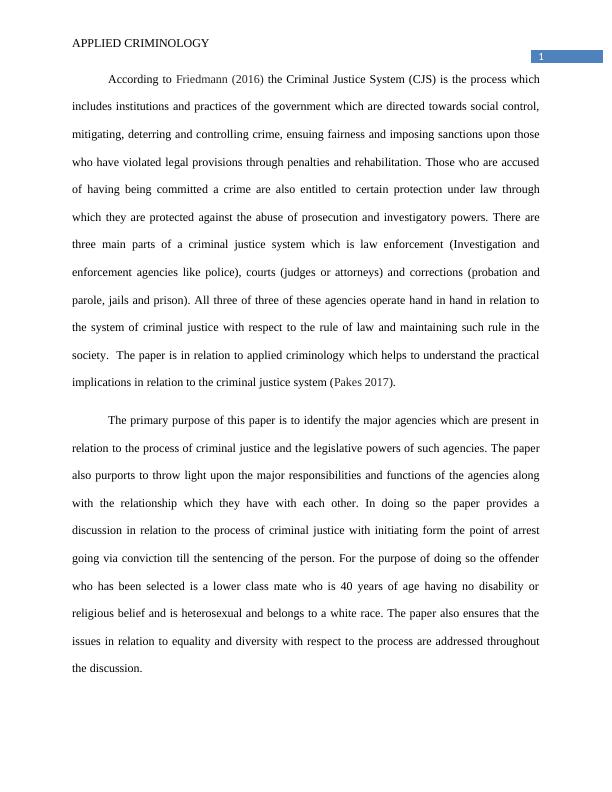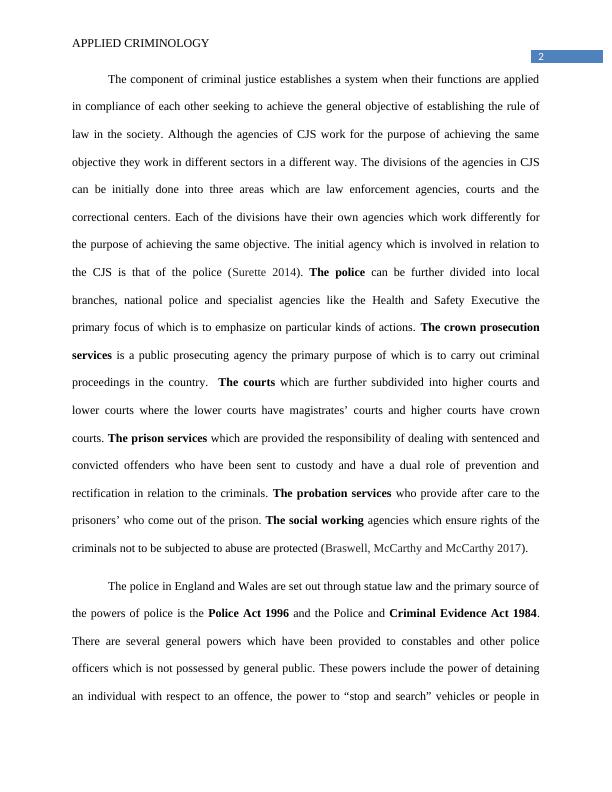Criminal Justice System - Assignment
Added on 2021-06-17
12 Pages3619 Words3 Views
Running head: APPLIED CRIMINOLOGYApplied Criminology Name of the studentName of the universityAuthor note

1APPLIED CRIMINOLOGYAccording to Friedmann (2016) the Criminal Justice System (CJS) is the process whichincludes institutions and practices of the government which are directed towards social control,mitigating, deterring and controlling crime, ensuing fairness and imposing sanctions upon thosewho have violated legal provisions through penalties and rehabilitation. Those who are accusedof having being committed a crime are also entitled to certain protection under law throughwhich they are protected against the abuse of prosecution and investigatory powers. There arethree main parts of a criminal justice system which is law enforcement (Investigation andenforcement agencies like police), courts (judges or attorneys) and corrections (probation andparole, jails and prison). All three of three of these agencies operate hand in hand in relation tothe system of criminal justice with respect to the rule of law and maintaining such rule in thesociety. The paper is in relation to applied criminology which helps to understand the practicalimplications in relation to the criminal justice system (Pakes 2017). The primary purpose of this paper is to identify the major agencies which are present inrelation to the process of criminal justice and the legislative powers of such agencies. The paperalso purports to throw light upon the major responsibilities and functions of the agencies alongwith the relationship which they have with each other. In doing so the paper provides adiscussion in relation to the process of criminal justice with initiating form the point of arrestgoing via conviction till the sentencing of the person. For the purpose of doing so the offenderwho has been selected is a lower class mate who is 40 years of age having no disability orreligious belief and is heterosexual and belongs to a white race. The paper also ensures that theissues in relation to equality and diversity with respect to the process are addressed throughoutthe discussion.

2APPLIED CRIMINOLOGYThe component of criminal justice establishes a system when their functions are appliedin compliance of each other seeking to achieve the general objective of establishing the rule oflaw in the society. Although the agencies of CJS work for the purpose of achieving the sameobjective they work in different sectors in a different way. The divisions of the agencies in CJScan be initially done into three areas which are law enforcement agencies, courts and thecorrectional centers. Each of the divisions have their own agencies which work differently forthe purpose of achieving the same objective. The initial agency which is involved in relation tothe CJS is that of the police (Surette 2014). The police can be further divided into localbranches, national police and specialist agencies like the Health and Safety Executive theprimary focus of which is to emphasize on particular kinds of actions. The crown prosecutionservices is a public prosecuting agency the primary purpose of which is to carry out criminalproceedings in the country. The courts which are further subdivided into higher courts andlower courts where the lower courts have magistrates’ courts and higher courts have crowncourts. The prison services which are provided the responsibility of dealing with sentenced andconvicted offenders who have been sent to custody and have a dual role of prevention andrectification in relation to the criminals. The probation services who provide after care to theprisoners’ who come out of the prison. The social working agencies which ensure rights of thecriminals not to be subjected to abuse are protected (Braswell, McCarthy and McCarthy 2017). The police in England and Wales are set out through statue law and the primary source ofthe powers of police is the Police Act 1996 and the Police and Criminal Evidence Act 1984.There are several general powers which have been provided to constables and other policeofficers which is not possessed by general public. These powers include the power of detainingan individual with respect to an offence, the power to “stop and search” vehicles or people in

3APPLIED CRIMINOLOGYrelation to suspicion of offence, the power of arresting people in case off minor offences withouta warrant and the power of diverting the conduct of a vehicle and person on highways as well asother public places. These powers are imposed with several limits in relation to allowing thepublic to be peacefully work in the society. These powers have to be used by the police whenthey have a clear reason as to why they have to use their power. Such reason has to be alsonotified to the person who is being arrested or detained. On limited basis powers to stop andsearch can be extended such as under ss.44-47 of the Terrorism Act 2000 or s.60 of theCriminal Justice and Public Order Act 1994. Once the process of arrest has been compliedwith and the person has been arrested the police gas the right to search the property of the personwithout requiring any warrant so that they can collect evidence required to justify the arrest. Theprimary source of powers in relation to police in the UK are provided under the Police Act 1996covering powers of jurisdiction under section 30, attestation under section 29, and a few othermatters. Police Reform Act 2002 gives powers to the police community support officer or acommunity support officer. The powers of the police can be further subdivided into Detention(without arrest, after arrest and after charge), Search without Warrant, Arrest without Warrant,powers of entry and other powers like road checks and Removal of disguises (Wood andMacManus 2017). All form of criminal cases in UK initiate in the magistrate courts which are heard bymagistrates or a district judge. The primary rules which govern the powers provided to the courtsare The Criminal Procedure Rules and Powers of Criminal Courts (Sentencing) Act 2000.Summary offences such as motoring offences, disorderly and drunk offences and minor criminaldamages are dealt with by the courts. The magistrate courts also have the power to deal withoffences like drug and burglary offences. These offences are known as either way offences

End of preview
Want to access all the pages? Upload your documents or become a member.
Related Documents
Criminal Justice System Assignmentlg...
|9
|2612
|108
Introduction to the Criminal Justice Systemlg...
|8
|2577
|425
Advanced Topics in Criminology in Australialg...
|11
|2685
|44
Criminology and Criminal Justicelg...
|4
|691
|287
Victims of Crime: The Criminal Justice System in the United Kingdomlg...
|12
|3710
|71
Criminology and Criminal Justicelg...
|5
|896
|145
